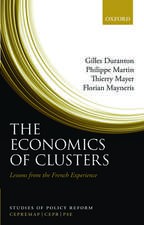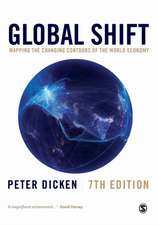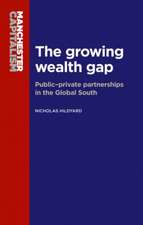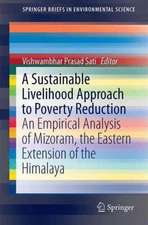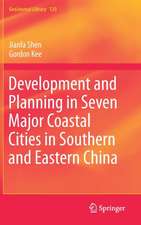Spatial Knowledge Spillovers and the Dynamics of Agglomeration and Regional Growth: Contributions to Economics
Autor Max C. Keilbachen Limba Engleză Paperback – 14 sep 2000
Din seria Contributions to Economics
- 18%
 Preț: 1001.81 lei
Preț: 1001.81 lei -
 Preț: 90.83 lei
Preț: 90.83 lei - 15%
 Preț: 649.06 lei
Preț: 649.06 lei - 18%
 Preț: 1109.92 lei
Preț: 1109.92 lei - 24%
 Preț: 657.09 lei
Preț: 657.09 lei - 18%
 Preț: 976.54 lei
Preț: 976.54 lei - 17%
 Preț: 361.03 lei
Preț: 361.03 lei - 18%
 Preț: 1027.83 lei
Preț: 1027.83 lei -
 Preț: 283.93 lei
Preț: 283.93 lei - 15%
 Preț: 644.95 lei
Preț: 644.95 lei - 15%
 Preț: 638.24 lei
Preț: 638.24 lei -
 Preț: 394.29 lei
Preț: 394.29 lei - 15%
 Preț: 636.80 lei
Preț: 636.80 lei - 15%
 Preț: 637.78 lei
Preț: 637.78 lei - 18%
 Preț: 723.69 lei
Preț: 723.69 lei - 15%
 Preț: 635.47 lei
Preț: 635.47 lei - 15%
 Preț: 634.00 lei
Preț: 634.00 lei -
 Preț: 392.75 lei
Preț: 392.75 lei -
 Preț: 383.33 lei
Preț: 383.33 lei - 15%
 Preț: 637.28 lei
Preț: 637.28 lei - 15%
 Preț: 636.80 lei
Preț: 636.80 lei - 18%
 Preț: 950.96 lei
Preț: 950.96 lei - 15%
 Preț: 634.68 lei
Preț: 634.68 lei -
 Preț: 387.38 lei
Preț: 387.38 lei - 15%
 Preț: 647.27 lei
Preț: 647.27 lei - 15%
 Preț: 636.63 lei
Preț: 636.63 lei - 15%
 Preț: 639.73 lei
Preț: 639.73 lei -
 Preț: 385.62 lei
Preț: 385.62 lei - 15%
 Preț: 641.85 lei
Preț: 641.85 lei - 20%
 Preț: 649.60 lei
Preț: 649.60 lei - 15%
 Preț: 641.71 lei
Preț: 641.71 lei -
 Preț: 387.96 lei
Preț: 387.96 lei - 15%
 Preț: 645.47 lei
Preț: 645.47 lei -
 Preț: 385.08 lei
Preț: 385.08 lei - 15%
 Preț: 646.62 lei
Preț: 646.62 lei - 15%
 Preț: 638.43 lei
Preț: 638.43 lei -
 Preț: 381.21 lei
Preț: 381.21 lei - 15%
 Preț: 642.51 lei
Preț: 642.51 lei - 15%
 Preț: 637.78 lei
Preț: 637.78 lei - 15%
 Preț: 641.71 lei
Preț: 641.71 lei -
 Preț: 384.70 lei
Preț: 384.70 lei -
 Preț: 379.86 lei
Preț: 379.86 lei -
 Preț: 378.34 lei
Preț: 378.34 lei -
 Preț: 384.70 lei
Preț: 384.70 lei -
 Preț: 388.52 lei
Preț: 388.52 lei - 15%
 Preț: 641.71 lei
Preț: 641.71 lei -
 Preț: 381.00 lei
Preț: 381.00 lei - 15%
 Preț: 644.95 lei
Preț: 644.95 lei -
 Preț: 386.00 lei
Preț: 386.00 lei
Preț: 383.33 lei
Nou
Puncte Express: 575
Preț estimativ în valută:
73.36€ • 79.66$ • 61.62£
73.36€ • 79.66$ • 61.62£
Carte tipărită la comandă
Livrare economică 22 aprilie-06 mai
Preluare comenzi: 021 569.72.76
Specificații
ISBN-13: 9783790813210
ISBN-10: 3790813214
Pagini: 208
Ilustrații: X, 194 p.
Dimensiuni: 155 x 235 x 11 mm
Greutate: 0.3 kg
Ediția:2000
Editura: Physica-Verlag HD
Colecția Physica
Seria Contributions to Economics
Locul publicării:Heidelberg, Germany
ISBN-10: 3790813214
Pagini: 208
Ilustrații: X, 194 p.
Dimensiuni: 155 x 235 x 11 mm
Greutate: 0.3 kg
Ediția:2000
Editura: Physica-Verlag HD
Colecția Physica
Seria Contributions to Economics
Locul publicării:Heidelberg, Germany
Public țintă
ResearchCuprins
1 Introduction and Motivation.- 2 Why and How Does Economic Activity Grow? An Overview of the Literature.- 3 Why and How Does Economic Activity Concentrate in Space? Another Overview of the Literature.- 4 Spatial Knowledge Spillovers and the Dynamics of Agglomeration and Regional Growth.- 5 Marshallian Externalities, Spatial Self-Organization and Regional Growth — an Agent Based Approach.- 6 Spatial Processes in the Economy — an Empirical Investigation.- 7 Summary and Conclusion.- A Generalization of the Model Developed in Chapter 4.- A. 1 Illustration of the Allocation Dynamics for a Region with an Arbitrary Number of Firms.- A.2 Proof that Firms Employ Identical Factor Ratios or Identical Factor Shares.- B Mathematical Appendix.- B.l Proof that the Bias of an OLS Estimation in the Presence of Spatial Autocorrelation is Biased.- B.2 Derivation of the Log-Likelihood Function of Model (6.2).- C Data.- List of Symbols.- List of Figures.- List of Tables.- References.
Textul de pe ultima copertă
When considering the dynamics of regional growth rates, one usually observes growth convergence on spatial aggregates but non-convergence or even divergence within smaller regions of different type. This book suggests various approaches to investigate this puzzle. A formal model, merging approaches from growth theory and new economic geography, shows that spatial knowledge spillovers might be the driving force behind this behavior. To analyze an arbitrary number of regions, the model is implemented on a locally recursive simulation tool - cellular automata. Convergence regressions from different runs of the automaton confirm previous findings. Finally, the existence of spatial knowledge spillovers is tested. Regressions give strong evidence for spatial knowledge spillovers. All the relevant literature and spatial econometric methods are surveyed. Data is reproduced in the appendix.


